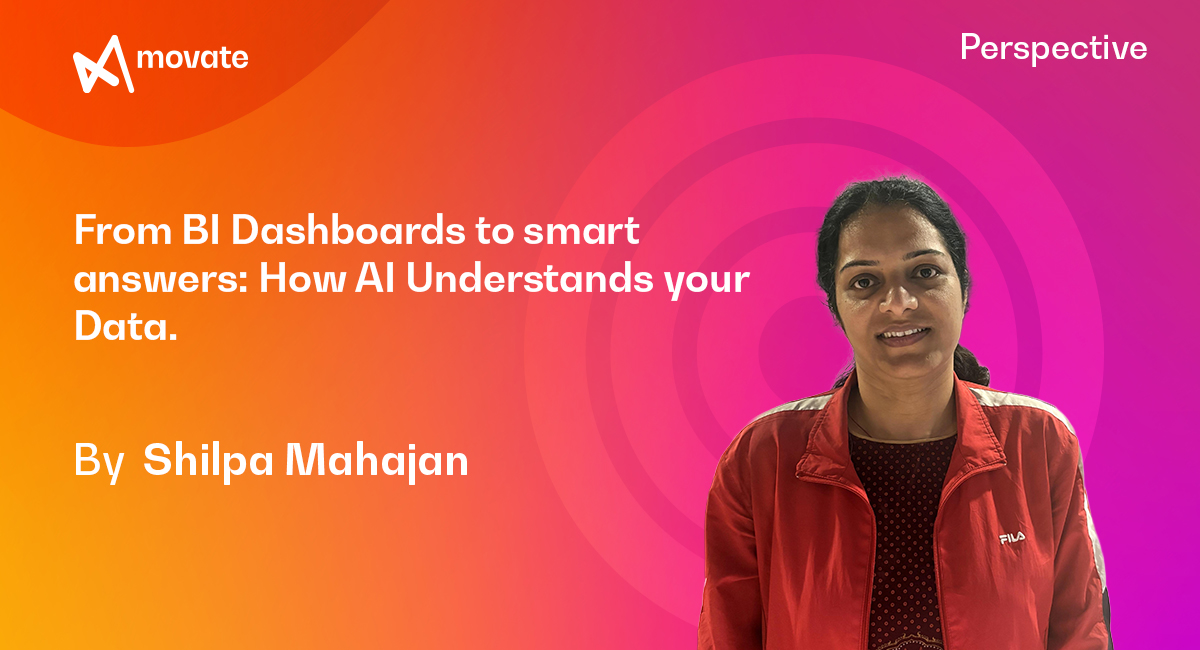
Traditional business intelligence (BI) dashboards have long provided the foundation for data-driven decision-making in organizations; however, significant limitations exist in the reliance on manually built queries and static reporting. The information received is often delayed, rigid, and lacks real-time contextualization.
For example, traditional dashboards will not address the timely identification of anomalies or provide actionable predictive insights, both of which lead to missing incidental small events and ultimately longer decision-making times. The adoption rate of BI dashboards continues to be low, at nearly 20%, with many people either overwhelmed by them or finding them static and not meeting the dynamic demands of the business.
Gone are the days when businesses relied on visualizations and charts to draw conclusions from data. Today, conversational AI interfaces are transforming business intelligence. Employees can ask questions in their own words and receive immediate responses. This is good for internal teams and the overall enterprise to push data and uncover insights faster and more accurately.
The Limitations of Conventional Dashboards
Dashboards have long been a pillar of business intelligence, but at present, they often lack the depth and agility seen by decision-makers as necessary. By design, many dashboards are retroactive, showing what has already happened and rarely allowing for insights into the events that occurred or how they might influence future outcomes. This backward-looking nature means organizations are left reacting to data instead of anticipating and shaping what comes next.
Another limitation is the complexity of interpretation. Dashboards are often cluttered with dozens of charts, tables, and KPIs that lack clear context or narrative flow. As a result, identifying the key signal in a sea of metrics becomes difficult, slowing down the path to actionable insight. Even subtle anomalies or emerging patterns signals that could represent risks or opportunities can easily be overlooked, leading to missed chances for timely intervention.
Some of the common challenges associated with traditional dashboards include:
Historical View – Dashboards emphasize performance that has already occurred, with limited capacity to clarify reasons or prompt future action.
Static and Inflexible – There is little to no flexibility; getting new perspectives or following up often requires development time for an analyst.
Cognitive Overload – Having too many visualizations can overwhelm employees, especially non-technical and non-analytical employees.
Low Engagement – Employees often view systems as complicated and disconnected from reality or actual decision making, which causes them to disengage from dashboards.
The Shift from Reporting to Intelligent Decision-Making
The issue with conventional BI dashboards is that they accommodate companies simply “seeing data”, rather than comprehending it. Businesses require fast, contextual, and predictive insights, not just stagnant visuals that speak to past performance. Decisions are not made on quarterly or monthly reports anymore; organizations need to be aware of trends, anomalies, and impending opportunities as they come up in real time. Context is equally important, as data alone means nothing when the story behind it is unknown.
Comprehending data is important because it allows companies to connect the dots, identify trends, and ultimately predict what may be next. Without comprehension of what data means, the data is still descriptive and merely tells you what happened. It is not diagnostic or prescriptive and does not tell you why or what to do about it. This predictive power allows organizations to see forthcoming challenges and take action accordingly.
For example, knowing sales are going down is useful; understanding what caused the drop – whether it was seasonality, supply chain issues, or competition is what allows decision makers to take action. This is not just a technological shift; this is a fundamental change in how companies work with their data. Organizations can go from dashboards to AI-driven, conversational insights and can
- Ask questions in plain language and get actionable answers instantly.
- Detect anomalies and trends as they happen, reducing missed opportunities.
- Empower all employees, not just analysts, to make data-driven decisions.
- Accelerate decision-making, turning insights into actions without delay.
Turning static data into AI-driven smart answers
AI is reshaping traditional BI by converting stagnant dashboards into interactive, intelligent systems and going beyond mere data display. Conversational interfaces empower any person in an organization to query in plain language and obtain immediate, actionable insights.
For example, Microsoft Power BI with Copilot lets employees simply type or speak questions like “Show me last quarter’s sales by region” or “What factors are driving churn in the east zone.” Instead of digging through dashboards or writing queries, they get instant, visual, and contextual insights.
Similarly another example being, Tableau integrated with Salesforce Einstein AI allows users to ask questions such as “Which customer segment is most likely to renew their contracts this quarter?” and automatically generates explanations, predictive trends, and recommended actions.
AI also takes BI beyond reactive queries by adding proactive intelligence. It can detect anomalies such as a sudden spike in product returns before they affect revenue, surface emerging demand trends in a new geography, or send real-time alerts when inventory dips below forecasted levels. Predictive and prescriptive analytics enhance this further by helping businesses anticipate outcomes and act accordingly.
This allows decision-makers to move faster, more confidently, and more accurately. The advantages of AI-powered BI are obvious: decision-making cycles get faster, employees have a higher level of adoption, insights are actionable instead of just descriptive, minor anomalies or opportunities are no longer overlooked, and the organization has a strategic advantage through predictive foresight that leads to more innovative and better business outcomes.
How Prescience and Movate Transformed BI Dashboards into Smart, Actionable Insights
A leading retail company with more than 150 locations could not track store performance, and reporting was inefficient due to static, siloed dashboards. In line with the natural evolution from traditional BI to AI-based, intelligent decision making, Prescience Decision Solutions, a Movate company, deployed a KPI-based retail intelligence solution that automated refreshing data, introduced more than 30 optimized KPI-based reports, and created performance alerts to provide insight in real-time.
This enabled the company to gain insights faster and with greater accuracy and put decision-makers in a position to make proactive decisions to reset the business’s course. Reporting improved 50x, and the organization was empowered to act quickly and effectively on key performance indicators (KPIs) and next-to-next trends.
To know more click here.
The Road Ahead The transformation from static dashboards to AI-powered, conversational BI signifies a profound change from organizations managing data. Organizations can now go beyond retroactive reporting to anticipating trends, revealing latent opportunities, and acting in the moment decisively. Data is no longer simply seen, it is understood, interpreted, and converted to smarter initiatives that yield a competitive advantage that is more than numbers on a screen.
About the author

Shilpa Mahajan is an experienced BI Lead with over 8 years in data analytics, visualization, and performance reporting. She specializes in end-to-end Power BI solutions, transforming raw data into actionable insights via SQL, Tableau, and data warehousing expertise.
She has led enterprise-scale dashboard and migration projects, focusing on ETL automation and optimization, while bridging technical delivery with strategic business outcomes.
A certified Microsoft Power BI Data Analyst (PL-300), MCSA in Data Visualization, and Tableau Desktop Specialist, Shilpa is passionate about using data to drive performance, streamline reporting, and enable automation.
